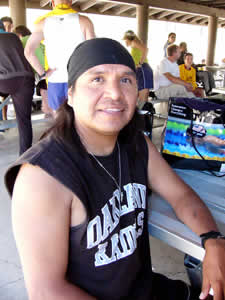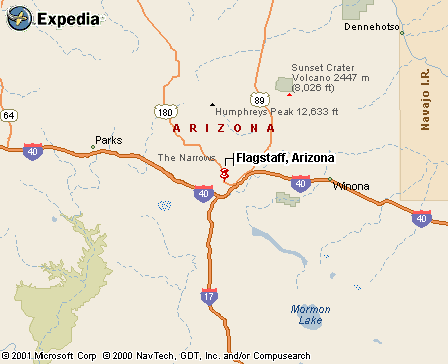|
|
Canku Ota |
|
|
(Many Paths) |
||
|
An Online Newsletter Celebrating Native America |
||
|
July 3, 2004 - Issue 116 |
||
|
|
||
|
NACA Prayer Run more than a race |
||
|
by S.J. Wilson - The Navajo-Hopi Observer |
||
|
credits: photo 1: Students from the Puente De Hozhó bilingual school delivered the National Anthem and the Pledge of Allegiance in the Navajo language.; photo 2: Wensler Nosie |
|
With parents looking proudly on, the kindergarten through second-grade students sang with confidence and gusto. This performance served as a reminder that although many view Native Americans for Community Action's (NACA) Prayer Run as an important opportunity to train for longer events later in the season, to many others this event is a family affair. Shirley Nez, the mother of first grader Hannah, made it evident she feels very strongly about this race—and her daughter's school. For Nez, both are about the survival of her culture, and she sends a passionate message to the elderly who fear the loss of their way of life. "Anything we do for our kids, we do for all of them," Nez said. "We want them to know that their culture is not lost." Nez encourages Navajo parents to take the opportunity Puente De Hozhó offers, saying that their children can be fluent in their native language and culture. "It's taken me almost 30 or 40 years to learn. If I can do it, anyone can," Nez said. There
are many familiar faces in the crowd—faces that have become
part of the Prayer Run family. Steve Darden is still running the
race after helping bring it to existence many years earlier. Darden,
one of the founders of NACA, said he especially enjoyed the presentation
by the young students. NACA has been instrumental in helping urban Native Americans overcome many issues they face off the reservation, including cultural preservation. One runner, who works as a radiation therapist, runs in support of these contributions. "I admire an organization like NACA—one giving back to the culture," the runner said. "I appreciate NACA's cultural and health education programs, because there is an overabundance of health problems thrown on Native Americans." Poverty and exposure to radiation are just an example of this. Other runners participate for the pleasure of running. One woman said she participated to train for another race, while another ran just to see if she could finish. "I"ve always wanted to run a marathon," she admitted. For others, the Prayer Run is a way to memorialize a loved one who has passed on. Rob Wagner has been attending the race for four years now, and this year a bad knee left him sitting at the sidelines. But his hands were busy as he worked on a piece of wood he"d found earlier. Wagner is the artisan who has provided the beautifully carved hiking stick to the fifth runner of the 10K to cross the finish line for the last three years. He does this in honor of his daughter, Kelly. Although Wagner said he has always loved the woods, it was his daughter who got him hooked on running. "We all look for inspiration in different places," Wagner said. "Kelly is mine. Runners are a rare breed—running is a punishing sport. It takes a lot of strength." Kelly, he said, had that strength. He described himself as a hermit but said running does provide him with a social outlet. "I make new friends and hear new stories. Many people wonder why Wagner's hand-carved sticks go to the fifth place runner. The answer is simple. Five was Kelly's number when she performed. Wagner described his home as being full of sticks, collected on different walks and runs in the forest. "They are hanging everywhere," he admitted. "It's like peanuts. I can't get enough of them." For Wagner, living in Flagstaff satisfies two of his greatest loves. "I love to run and here in Flagstaff we have beautiful trails and forests," he said. Of Cherokee ancestry, Wagner admitted that he is thrilled to live in a community with such diverse culture.
Nosie leads the fight for another sacred mountain—Mt. Graham—which is very significant to the San Carlos Apache. Once arrested for attempting to pray at a sacred site on Mt. Graham, Nosie was charged with trespassing because he'd entered a place declared off-limits without a permit because of the telescope that is situated on the mountain. Nosie, along with other Apache and their supporters, continue their own battle to protect their ancestral rights to a sacred mountain. "We have come again to give our annual support," Nosie said. "We"ve also spent time in the forest to offer prayers." Of his own effort back home, Nosie said that there has been renewed interest in the Mt. Graham effort. "This year, our tribal council refused financial support from universities in Arizona and Minnesota," Nosie said. "This gave these universities a black eye to their allegations that our people are in support of the telescope. The tribal council's action has revitalized our efforts." One cannot spend a morning among the organizers and runners of NACA's annual Sacred Mountain Prayer Run without realizing that this race means many things to many different people. Under the steady face of the San Francisco Peaks, runners enjoy breathtaking scenery, high-altitude training, some very personalized awards as well as a glimpse at the Native American culture that has made Flagstaff unique. The staff of NACA has created a race that is equally unique. |
|
|
www.expedia.com |
|
|
||
|
|
||
| Canku Ota is a free Newsletter celebrating Native America, its traditions and accomplishments . We do not provide subscriber or visitor names to anyone. Some articles presented in Canku Ota may contain copyright material. We have received appropriate permissions for republishing any articles. Material appearing here is distributed without profit or monetary gain to those who have expressed an interest. This is in accordance with Title 17 U.S.C. Section 107. | ||
|
Canku Ota is a copyright © 2000, 2001, 2002, 2003, 2004 of Vicki Barry and Paul Barry. |
||
 |
 |
|
|
The "Canku Ota - A Newsletter Celebrating Native America" web site and its design is the |
||
|
Copyright © 1999, 2000, 2001, 2002, 2003, 2004 of Paul C. Barry. |
||
|
All Rights Reserved. |
||
 FLAGSTAFF
— This year's Sacred Mountain Prayer Run began on June
5 with a very special appearance as students from the Puente De
Hozhó bilingual school delivered the National Anthem and
the Pledge of Allegiance in the Navajo language.
FLAGSTAFF
— This year's Sacred Mountain Prayer Run began on June
5 with a very special appearance as students from the Puente De
Hozhó bilingual school delivered the National Anthem and
the Pledge of Allegiance in the Navajo language. It
is culture that brings Wensler Nosie back to Flagstaff for the Prayer
Run every year. Nosie, a member of the San Carlos Apache Tribe,
brings family members and friends with him each year to emphasize
the cultural importance of the San Francisco Peaks—the mountain
that gives the race it's name.
It
is culture that brings Wensler Nosie back to Flagstaff for the Prayer
Run every year. Nosie, a member of the San Carlos Apache Tribe,
brings family members and friends with him each year to emphasize
the cultural importance of the San Francisco Peaks—the mountain
that gives the race it's name. 